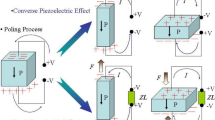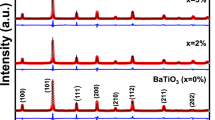Abstract—
We have studied the crystal structure and dielectric and local piezoelectric properties of (Na0.5Bi0.5)(Ti1–xMnx)O3 (x = 0–0.1) modified sodium bismuth titanate-based ceramics and observed the formation of a pseudocubic phase with the perovskite structure. Its unit-cell volume first decreases and then, for x ≥ 0.05, increases. The ceramics undergo phase transitions, which show up as anomalies in their dielectric permittivity near ~450 K and peaks at a Curie temperature of ~600 K. As x increases to 0.04, their Curie temperature decreases by 40 K. The phase transitions near 450 K exhibit well-defined relaxor behavior due to the presence of polar regions in the nonpolar matrix. The samples with x < 0.05 have been shown to have an increased room-temperature dielectric permittivity, which correlates with the increased effective piezoelectric coefficient, suggesting that doping with manganese has an advantageous effect on the functional properties of sodium bismuth titanate ceramics.









Similar content being viewed by others
Change history
14 January 2022
An Erratum to this paper has been published: https://doi.org/10.1134/S0020168521120165
REFERENCES
Smolenskii, G.A., Isupov, V.A., Agranovskaya, A.I., and Krainik, N.N., New ferroelectrics of complex composition, Fiz. Tverd. Tela (Leningrad), 1961, vol. 2, pp. 2651–2654.
Vakhrushev, S.B., Isupov, V.A., Kvyatkovsky, B.E., Okuneva, N.M., Pronin, I.P., Smolensky, G.A., and Syrnikov, P.P., Phase transitions and soft modes in sodium bismuth titanate, Ferroelectrics, 1985, vol. 63, pp. 153–160.
Zhang, S.J., Xia, R., and Shrout, R.T., Lead-free piezoelectric ceramics: alternatives for PZT?, J. Electroceram., 2007, vol. 19, pp. 251–257.
Takenaka, T., Nagata, H., and Hiruma, Y., Current developments and prospective of lead-free piezoelectric ceramics, Jpn. J. Appl. Phys., 2008, vol. 47, pp. 3787–3801.
Panda, P.K., Review: environmental friendly lead-free piezoelectric materials, J. Mater. Sci., 2009, vol. 44, pp. 5049–5062.
Coondoo, I., Panwar, N., and Kholkin, A., Lead-free piezoelectrics: current status and perspectives, J. Adv. Dielectr., 2013, vol. 3, paper 1330002.https://doi.org/10.1142/S2010135X13300028/
Reichmann, K., Feteira, A., and Li, M., Bismuth sodium titanate based materials for piezoelectric actuators, Materials, 2015, vol. 8, pp. 8467–8495. https://doi.org/10.3390/ma8125469
Rödel, J., Webber, K.G., Dittmer, R., Wook Jo, Kimura, M., and Damjanovic, D., Transferring lead-free piezoelectric ceramics into application, J. Eur. Ceram. Soc., 2015, vol. 35, pp. 1659–1681.https://doi.org/10.1016/j.jeurceramsoc.2014.12.013
Rödel, J. and Li, J., Lead-free piezoceramics: status and perspectives, MRS Bull., 2018, vol. 43, pp. 576–580.https://doi.org/10.1557/mrs.2018.181
Vodyanoy, V.J. and Mnyukh, Y., The physical nature of “giant” magnetocaloric and electrocaloric effects, Am. J. Mater. Sci., 2013, vol. 3, no. 5, pp. 105–109.https://doi.org/10.5923/j.materials.20130305.01
Weyland, F., Acosta, M., Koruza, J., Breckner, P., Rodel, J., and Novak, N., Criticality: concept to enhance the piezoelectric and electrocaloric properties of ferroelectrics, Adv. Funct. Mater., 2016, vol. 26, pp. 7326–7333.
Kumar, A., Thakre, A., Jeong, D.Y., and Ryu, J., Prospects and challenges of the electrocaloric phenomenon in ferroelectric ceramics, J. Mater. Chem. C, 2019, vol. 7, pp. 6836–6859.https://doi.org/10.1039/c9tc01525f
Feng Li, Biao Lu, Jiwei Zhai, Bo Shen, Huarong Zeng, Shengguo Lu, Viola, G., and Haixue Yan, Enhanced piezoelectric properties and electrocaloric effect in novel lead-free (Bi0.5K0.5)TiO3–La(Mg0.5Ti0.5)O3 ceramics, J. Am. Ceram. Soc., 2018, vol. 101, pp. 5503–5513.https://doi.org/10.1111/jace.15812
Gorfman, S. and Thomas, P.A., Evidence for a non-rhombohedral average structure in the lead-free piezoelectric material Na0.5Bi0.5TiO3, J. Appl. Crystallogr., 2010, vol. 43, pp. 1409–1414.
Jones, G.O. and Thomas, P.A., Investigation of the structure and phase transitions in the novel A-site substituted distorted perovskite compound Na0.5Bi0.5TiO3, Acta Crystallogr., Sect. B: Struct. Sci., 2002, vol. 58, no. 2, pp. 168–178.
Aksel, E., Foronda, H., Calhoun, K.A., Jones, J.L., Schaab, S., and Granzow, T., Processing and properties of Na0.5Bi0.5TiO3 piezoelectric ceramics modified with La, Mn and Fe, Funct. Mater. Lett., 2010, vol. 3, no. 1, paper 4548.
Davies, M., Aksel, E., and Jones, J.L., Enhanced high-temperature piezoelectric coefficients and thermal stability of Fe- and Mn-substituted Na0.5Bi0.5TiO3 ceramics, J. Am. Ceram. Soc., 2011, vol. 94, no. 5, pp. 1314–1316.
Suchanicz, J., Sitko, D., Svirskas, S., Ivanov, M., Kezionis, A., Banys, J., Czaja, P., Kruzina, T.V., and Szcze Rsny, J., Ferroelectric, dielectric and optic properties of Mn and Cr-doped Na0.5Bi0.5TiO3 single crystals, Ferroelectrics, 2018, vol. 532, pp. 38–49.https://doi.org/10.1080/00150193.2018.1499402
Coondoo, I., Ferroelectrics, Shanghai: InTech China, 2010.
Aksel, E., Erdem, E., Jakes, P., Jones, J.L., and Eichel, R.-A., Defect structure and materials “hardening” in F2O3-doped (Bi0.5Na0.5)TiO3 ferroelectrics, Appl. Phys. Lett., 2010, vol. 97, paper 012903.
Yeon Soo Sung and Myong Ho Kim, Effects of B-site donor and acceptor doping in Pb-free (Bi 0.5 Na 0.5 )TiO 3 ceramics, Technical Ferroelectrics, Coondoo, I., Ed., 2010, pp. 217–230. http://www.intechopen.com/books/ferroelectrics/doping-effects-in-pb-free-bi0.5na0.5-tio3-ceramics
Koruza, J., Kodumudi Venkataraman, L., and Malic B., Magnetic, ferroelectric, and multiferroic metal oxides, Lead-Free Perovskite Ferroelectrics, chapter 3, pp. 51–69.https://doi.org/10.1016/B978-0-12-811180-2.00003-7
Li Ming, Zhang, H., Cook, S.N., Li Linhao, Kilner, J.A., Reaney, J.M., and Sinclair, D.C., The dramatic influence of A-site non-stoichiometry on the electrical conductivity and conduction mechanisms in the perovskite oxide Na0.5Bi0.5TiO3, Chem. Mater., 2015, vol. 27, pp. 629–634.
Politova, E.D., Strebkov, D.A., Mosunov, A.V., Golubko, N.V., Kaleva, G.M., Sadovskaya, N.V., and Stefanovich, S.Yu., Ferroelectric phase transitions in non-stoichiometric sodium–bismuth titanate ceramics, Bull. Russ. Acad. Sci.: Phys., 2018, vol. 82, no. 3, pp. 269–272.
Politova, E.D., Mosunov, A.V., Strebkov, V.A., Golubko, N.V., Kaleva, G.M., Loginov, B.A., Loginov, A.B., and Stefanovich, S.Yu., Phase formation and phase transitions in nonstoichiometric sodium bismuth titanate ceramics, Inorg. Mater., 2018, vol. 54, no. 7, pp. 744–748.
Shvartsman, V.V. and Lupascu, D.C., Lead-free relaxor ferroelectrics, J. Am. Ceram. Soc., 2012, vol. 95, pp. 1–26.
Hyeong Jae Lee and Shujun Zhang, in Lead-Free Piezoelectrics, Priya, Sh. and Nahm, S., Eds., New York: Springer, 2012, pp. 291–309.
Segalla, A.G., Nersesov, S.S., Kaleva, G.M., and Politova, E.D., Ways of improving functional parameters of high-temperature ferroelectric/piezoelectric ceramics based on BiScO3–PbTiO3 solid solutions, Inorg. Mater., 2014, vol. 50, no. 6, pp. 606–611.
Lee, G., Ji, J.-H., and Koh, J.-H., Enhanced piezoelectric properties of (Bi,Na)TiO3 –(Bi,K)TiO3 ceramics prepared by two-step sintering process, Int. J. Appl. Ceram. Technol., 2017, vol. 15, no. 2, pp. 531–537.https://doi.org/10.1111/ijac.12798
Kleemann, W., Random-field induced antiferromagnetic, ferroelectric and structural domain states, Int. J. Mod. Phys. B, 1993, vol. 7, pp. 2469–2507.
Funding
This work was supported by the Russian Foundation for Basic Research (project no. 21-53-12005) and the Russian Federation Ministry of Science and Higher Education (state research targets for the Semenov Federal Research Center for Chemical Physics, Russian Academy of Sciences (theme no. 45.22, state registration no. AAAA-A18-118012390045-2, project no. 0718-2020-0031) and the Crystallography and Photonics Federal Scientific Research Center, Russian Academy of Sciences).
Author information
Authors and Affiliations
Corresponding author
Additional information
Translated by O. Tsarev
Rights and permissions
About this article
Cite this article
Politova, E.D., Kaleva, G.M., Bel’kova, D.A. et al. Dielectric and Piezoelectric Properties of (Na0.5Bi0.5)(Ti1–xMnx)O3 (x = 0–0.1) Modified Ceramics. Inorg Mater 57, 942–949 (2021). https://doi.org/10.1134/S0020168521090120
Received:
Revised:
Accepted:
Published:
Issue Date:
DOI: https://doi.org/10.1134/S0020168521090120




